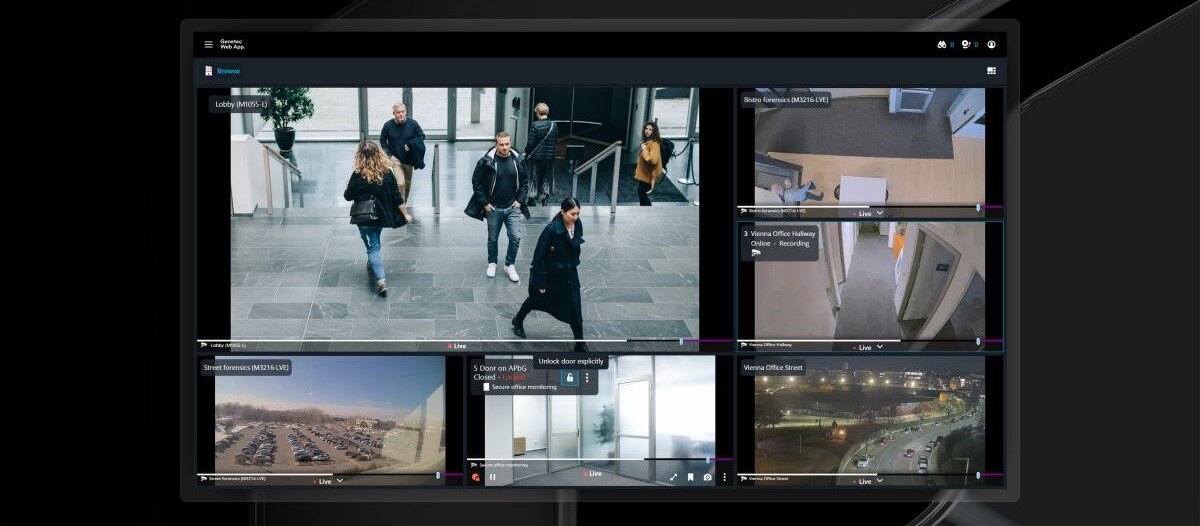A Unified Front
Optimizing physical security

Traditionally, facility management, security and information technology departments have operated somewhat independently. FM and security focus on the physical environment, while IT focuses on technology. The rise of connected buildings and smart technologies has changed that, and these teams must work together to reduce risk. As building safety and security requirements have been redefined in recent years, so have physical security systems. They have evolved from handling video surveillance and access control to becoming key to an organization’s digital transformation.
As FMs extend their work in the security realm, it is helpful to know how to assess physical security infrastructure to identify areas where more modern technologies can help manage risk more effectively and improve business operations.
Functionality on a single platform
The primary goal of a physical security system is to keep people, facilities and assets safe. These functions are often interdependent and work best when they are unified on a single platform. Unification gives users consistent experience across security tasks. For example, an FM could spot a door propped open, review video and determine why it was left open and by whom and provide reporting and trend analysis by door or user over time — all from the same interface.
Unification is different from integration, even though the terms are often used interchangeably. Integration relies on connections between independent solutions from multiple vendors. This often includes a patchwork of application programming interfaces that connect disparate systems. Managing integration points is costly, and too often the cost increases with time. Unification is more than integration. It brings all security applications together to address a broad range of security tasks, manage security policies, monitor events and run investigations. It is built from the ground up as a suite of products, using the same foundation to build, evolve and expand security operations over time.
More workloads are moving to the cloud, and it is important for the FM to find a truly hybrid platform that lets workloads run where they work best for the organization. Unification can include cloud and on-premises solutions, native and third-party data sources and components from a variety of vendors. All these capabilities coexist transparently and scale seamlessly as new technologies are added.
Open-architecture systems
No one wants to be locked into old technology. An open-architecture system uses non-proprietary components that can be sourced from third parties, allowing organizations to add components and possibly reuse existing components as needs evolve. Video cameras, access control modules, intercoms or other equipment with an open architecture give organizations maximum flexibility as business needs change. Open architecture is also easier to maintain because of the availability of third-party parts, and it is often less costly.
Cybersecurity capabilities
Open architecture does not mean that systems are unprotected; they are just easier to scale and maintain over time. Cybersecurity remains a separate, high priority for any technology, including physical security systems. Built-in cybersecurity tools make it easier to protect against possible threats, monitor system health and stay resilient in the face of cyberattacks. FMs should look for solutions that hold ISO 27001 certification or equivalent and include cybersecurity features by design, such as encryption for data, servers and all communications and granular authorization processes.
Working from a unified security platform, FM, IT and security teams can implement a single, global data protection and privacy strategy. Everything from the ways they encrypt data and enable multi-factor authentications to how they share evidence and define user privileges can be applied across all physical security systems. A unified platform creates a comprehensive view of real-time risks and effective tools to harden systems and devices.
Correlating data for better outcomes
Modern physical security systems have a single dashboard that shows the full range of security and operational data. They offer rich data visualization that can display data in maps, charts or histograms, rather than in databases and spreadsheets. This can help teams get to the real work faster, find valuable insights and uncover unexpected issues. Teams can identify patterns in security incidents and better understand how current security strategies measure up. From there, they might find opportunities to enhance incident response or make cost-saving improvements to standard operation protocols.
Not all shared data is specific to a security incident. Sometimes organizations want to track generalized information about visitor, employee or vehicle activities to support visitor management, employee experiences and traffic flow. This type of aggregated data provides information about broader trends while maintaining individual privacy. Critical data insights inform a range of facility operations, such as parking space utilization, traffic patterns and building occupancy, to create more convenient, efficient experiences.
While data from unified physical security systems can provide valuable insights, organizations must also protect data privacy. Regulations establish a minimum standard for how personal data should be stored and managed, but organizations can do more than the bare minimum. A modern security platform can include features to help FMs ensure that only authorized people access the data. Given accessibility management, it is possible for teams to control and monitor video while preserving individuals’ privacy by pixelating faces in videos to blur identities. Equally important is keeping detailed audit trails of all activities on the platform, including who accessed data and when.
Extended usage for business impact
Physical security systems operate successfully on their own to mitigate risk. When connected with building automation tools, they provide even greater protection and efficiencies for building operations. Security systems that collect data about building usage and occupancy can feed automated building systems, such as elevator dispatch, lighting, fire or HVAC operations, to streamline processes or schedule optimal maintenance.
With the rapid proliferation of Internet of Things (IoT) technology, the uses will only grow. FMs and other department leaders can use data across their systems to support their decision-making. A physical security system’s ability to connect seamlessly with intelligence tools is rapidly becoming an essential capability. This expansive view helps drive revenue and achieve efficiencies through smarter buildings.
Working with a reliable partner
While it may seem obvious, one of the most important decisions FMs can make is to choose a trusted technology partner to guide their organization. They should look for a physical security vendor with a stable financial track record and technology expertise in the industry. It is always a good idea for FMs to check with other companies or peer groups for recommendations.
After identifying vendors, FMs should dig a little deeper into how potential vendors plan to invest in future technologies. What percentage of their budget do they invest in research and development? What is their timeline for continual product updates? FMs should look for a partner with a smart business roadmap that will grow with the organization.
A forward-thinking collaboration with a physical security systems partner will be the most cost-effective way to stay current over time. The goal is to be able to keep security systems up to date by easily adding new technology and sensors as they become available. This ensures organizations can continually maximize value to their businesses.
Working together can take multiple forms
As roles converge and skill sets combine, organizations are taking different approaches to unify FM, IT and physical security. For some, IT teams are bringing FM and physical security representation into their group. In others, physical security and FM leaders are expanding their departments with IT skills. And some are broadening the security operations’ function to address security risks and capitalize on data coming from all groups.
There is no right or wrong approach to converging FM, IT and physical security teams. These departments have long-standing organizational strengths. They share a dedication to keeping the organization secure. In many cases, these teams have already found ways to adapt and work closely together to implement new projects and improve processes successfully. Unifying physical security systems can help organizations ease convergence and unlock the power of data.

Jeremy Hagen is regional director, enterprise for Genetec, Inc. In this role, he supports a team of account executives for the Western U.S., with a particular focus on the company’s enterprise sector. He joined Genetec in 2015, first working as a regional sales manager. He later advanced to a business development manager role, focusing on new and existing end-user engagement in the enterprise and critical infrastructure sector, before moving on to his current position.
Read more on Technology , Occupancy & Human Factors and Risk Management
Explore All FMJ Topics









